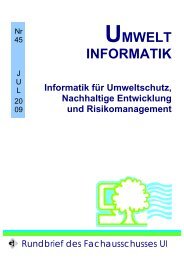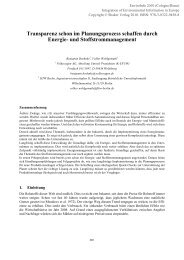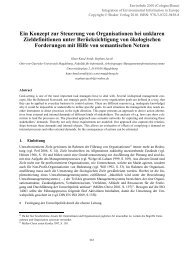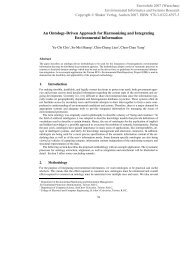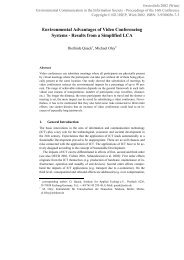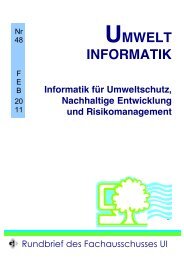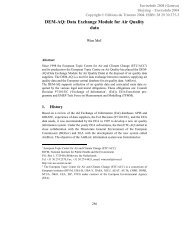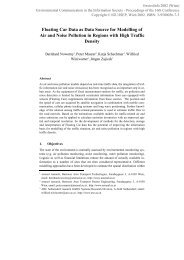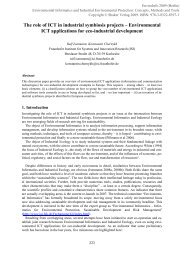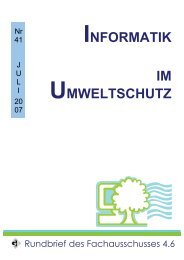the Case of Life Cycle Inventories - EnviroInfo
the Case of Life Cycle Inventories - EnviroInfo
the Case of Life Cycle Inventories - EnviroInfo
You also want an ePaper? Increase the reach of your titles
YUMPU automatically turns print PDFs into web optimized ePapers that Google loves.
as detailed as necessary for environmental assessment (Eul/Rey 2000, 214-222; Isenmann/Rautenstrauch2007, 76-79).Various studies have presented how environmental data could be integrated into ERP systems. Someare general models (Lang-Koetz/Heubach 2007), some concrete case studies on systems like infor:COM(Eul/Rey 2000) and SAP (Kuhrke/Feickert et al. 2008; Funk/Gómez et al. 2010).However, none <strong>of</strong> <strong>the</strong>se studies pay close attention to <strong>the</strong> source <strong>of</strong> environmental data. Often a vagueexplanation is given that data have been supplied by an EMIS, a web service or manual input. In <strong>the</strong> following,<strong>the</strong>refore, we describe what it looks like to acquire data from an environmental information systemtaking ecoinvent as an example.1.3 <strong>Life</strong> <strong>Cycle</strong> Assessment with ecoinvent<strong>Life</strong> <strong>Cycle</strong> Assessment (LCA) is a standardized method for estimating <strong>the</strong> environmental impacts <strong>of</strong> productsand services. Therefore material and energy flows occurring along <strong>the</strong> whole life cycle are counted inrelationship to <strong>the</strong> product output (Klöpffer/Grahl 2009, 1-4). LCA is not explicitly concerned with managementstructures or environmental plans (Krcmar/Dold et al. 2000, 15-16). However, an LCA can providea prerequisite for environmental management, i.e. by identifying crucial factors for environmentalimprovements.Within LCA <strong>the</strong>re is <strong>of</strong>ten a lack <strong>of</strong> information regarding material and energy flows. While an enterprisemay get specific data for some <strong>of</strong> its own activities, <strong>the</strong> environmental impacts <strong>of</strong> o<strong>the</strong>r own activitiesas well as impacts <strong>of</strong> upstream product chains have to be estimated with <strong>the</strong> help <strong>of</strong> generic backgrounddata (Klöpffer/Grahl 2009, 125-134).ecoinvent is one <strong>of</strong> <strong>the</strong> world’s leading databases for generic life cycle inventory data. With its comprehensivebasis <strong>of</strong> over 4000 datasets (Frischknecht/Jungbluth et al. 2005; Klöpffer/Grahl 2009, 138-139;Hilty 2008, 137-138) ecoinvent can serve as a basis for LCA in cases where <strong>the</strong>re is no specific data available.1.4 Steps towards an integration <strong>of</strong> ERP and ecoinventThe reference model depicted here describes <strong>the</strong> ERP-integrated creation <strong>of</strong> a simplified LCA with <strong>the</strong>help <strong>of</strong> ecoinvent. It is based on <strong>the</strong> model <strong>of</strong> Funk/Möller/Niemeyer (2009). The model assumes that <strong>the</strong>ERP is <strong>the</strong> leading corporate information system and thus also responsible for <strong>the</strong> process <strong>of</strong> LCA. Supportingsystems like ecoinvent are integrated with <strong>the</strong> help <strong>of</strong> a service-oriented architecture (SOA).Previous studies presented how environmentally relevant activities can be retrieved from <strong>the</strong> ERP masterdata; see for example Eul/Rey 2000; Isenmann/Rautenstrauch 2007; Kuhrke/Feickert et al. 2008;Funk/Niemeyer 2010. In addition, supplier-specific data can be used whenever it is available. Even downstreamactivities can be taken into account with <strong>the</strong> help <strong>of</strong> representative data and assumptions.Thus we argue that <strong>the</strong> ERP can determine all relevant activities occurring throughout <strong>the</strong> life cycle <strong>of</strong><strong>the</strong> given product. However, <strong>the</strong> environmental impacts <strong>of</strong> <strong>the</strong> activities remain unknown for <strong>the</strong> ERP.Therefore ecoinvent is used to ga<strong>the</strong>r <strong>the</strong> appropriate data and integrate it into <strong>the</strong> ERP.For that <strong>the</strong> ERP activities have to be mapped to <strong>the</strong> activities represented in ecoinvent first. Thus far, ithas not been possible to automatically collate data as part <strong>of</strong> a generic solution. Instead this task requires alot <strong>of</strong> manual intervention and expert knowledge. The precise mapping <strong>of</strong> activities is hindered by differentmethodical assumptions and <strong>the</strong> lack <strong>of</strong> a common vocabulary. This problem is called <strong>the</strong> semanticgap. It has previously been identified as <strong>the</strong> biggest single challenge for an automated life cycle assessmentby Funk/Möller/Niemeyer (2009).Copyright 2011 Shaker Verlag Aachen, ISBN: 978-3-8440-0451-9






